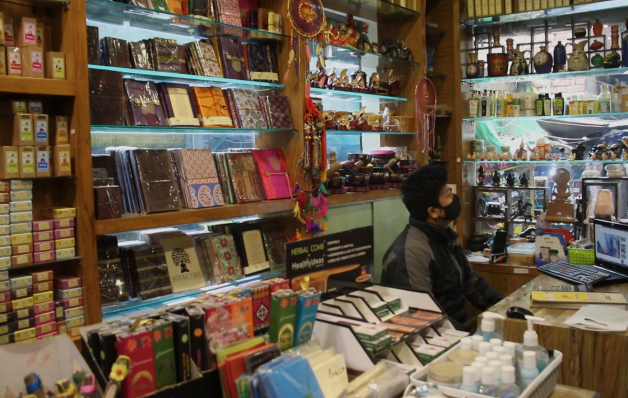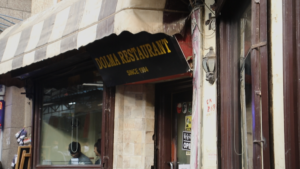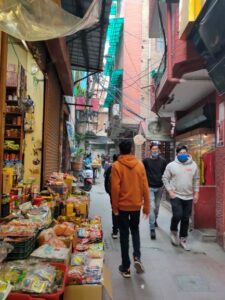Inside Majnu ka Tilla: Delhi’s own Mini Tibet

At Majnu ka Tilla, a store has diaries with Tibetan-inspired cover pages, Tibetan accessories and other sundries (MIG photos/Danish Mohamed)
Inside the crowded lanes of Majnu ka Tilla, the walls are painted in red, protesting against the Chinese occupation of Tibet. The walls read, “India-Tibet border, not India-China border.” The ‘Mini Tibet’ in the National Capital echoes the demands of a free Tibet. Furthermore, inside every shop in the Tilla, a picture of His Holiness Dalai Lama hangs on the top.
“It has been years since we settled in India, so we do not have any contacts left in Tibet. My family is settled in Dharamshala. I came to Delhi in 2004 to work and opened this shop,” says Tashi Wangdue, a Tibetan in his late 40s, who runs a retail store. Crammed in the northern part of Delhi, Majnu ka Tilla houses 3000 odd Tibetan families today. The community has been living here ever since Tibetans began to flee to India following tensions with China in the 1950s.
As soon as one enters Majnu ka Tilla, the shops and stalls are lined up a motley mix of Tibetan restaurants and apparel stores. People visiting here usually sit at these restaurants after a long stroll down the narrow shopping lanes. The market is frequented by college students for their Instagram feed who visit the locations for the dishes and ambience. At the heart of the refugee colony stands a Buddhist temple with a wide front yard, crowded by people clicking pictures of the quintessential Tibetan architecture. A short walk from the temple stands many stores that sell Tibetan accessories like keychains with holy symbols, diaries with Tibetan-inspired cover pages, religious fabrics with Thangka paintings and books and holy scriptures. Today, thanks to the strong Tibetan presence, the area has become a popular hangout location, attracting mainly the youth to its many cafes and shops.
“These nice, wintry days in Delhi are the best time to visit Majnu ka Tilla for the food out here, the entire atmosphere and the buzz. The people here are so nice to us. We bought some goodies from Mapcha. It is a design studio run by a lady who has some amazing designs,” says Shashwati, a journalist associated with an Indian media house, who was visiting the market with her friend Taranjali, a trainee manager at a cosmetic company.
For the visitors, Tibetan cuisine is the magnet. Ishita and Manvi, a pair of two best friends studying at Amity University, Noida, spent their entire afternoon at the Tilla. “I had Laphing today. I came here to try it. I bought chopsticks as well,” says Manvi while placing an order for a milkshake and a slice of blueberry cheesecake at Ama Cafe. While other restaurants like Dolma House and Tee Dee serve authentic Tibetan and Chinese cuisine, newcomers like Ama Cafe have westernised their menus by serving pancakes, burgers and other basics to appeal to the younger audience. Nevertheless, these famous restaurants have a huge waiting line during the rush hours.
Taranjali describes herself as a shopaholic and came to Mini Tibet to taste the Korean food. “I was here for the cafes and I was also eyeing for the Korean restaurants. I started my day with a breakfast at Ama cafe with a lovely window-side view and now Busan restaurant is left on my list. But I would just grab something like a local Tibetan cuisine and off to go,” she mentions.
Indeed, Majnu ka Tilla could not escape the global charge of all things Korean, led by its vibrant entertainment industry. Korean culture is duly reflected here as several shops selling Korean products and restaurants offering a variety of Korean delicacies have sprung up at Majnu ka Tilla.
Some of of the notable Korean shops here include Koja Store, Busan Korean Restaurant, Le Dragon House and other places that appeal to people looking for Korean household items to Korean foods. These restaurants play K-pop music to add a Korean charm to the ambience. “I am a big fan of K-pop. So, I came here to explore what this place has for me,” adds Ishita.
Warm welcome in the Tibetan alleys
The visitors here cherish not only the delectable food and the goods that they can get here, one of the main attractions of the Majnu ka Tilla is the warmth of the residents of this colony as they find that the inhabitants of the area, Tibetans, have a warm and sweet disposition. Mohammad Fayaz, a fruit seller, comes to the colony everyday with his basket of papaya, chiku (sapota), apples and bananas. “The people of this area are very nice and welcoming. There are some places where people do not let me come. But I don’t face any opposition here,” says Fayaz.
“It’s a lovely place to be. It’s a place where you can see little bit of Tibet and little bit of a place which is not typical Delhi. Here you get a flavour of a different world. Plus the shopkeepers are really friendly. The lady at the corner, who served us Laphing, was really nice to us,” adds Ishita.
But even the bustling Majnu ka Tilla could not escape the heat of the economic loss during the Covid-induced lockdown for a greater part of 2020 and continuing. Raju, who works at Barkhor Cafe, recalls working at a nearby cafe before the pandemic set in. “We used to have a good crowd all the time. Now the people rarely visit the cafes here. We hardly have more than 3-4 visitors even during weekend afternoons. We have cut short on our staff. Now it’s just us three running this cafe,” says Raju who came from Nepal to work in Delhi.
Koja store, a portmanteau of Korean and Japanese, selling household supplies, has also seen a sharp decline in the number of buyers. “When the lockdown happened, our store was shut like the rest of the market. Even after the lockdown was lifted, the store was relatively empty. While things have been recovering slowly, it is not like before the pandemic,” says Rose, an employee at Koja, who hails from Manipur.
Although Majnu ka Tilla has dealt a hard blow during the series of last year, the residents expect a good number of visitors this year. With things back on the recovery track, a bustling crowd can be found at quite a few places. But the marketplace would still take some time to recover from the economic shock.












